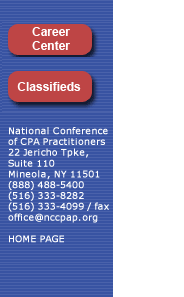

| |
|
|
|
|
|
|
|
|
|
|
|
|
|

August 2005
MEMBERS’ CORNER
BY STANLEY TEPPER, CPA, MBA
Estates – The following excerpts are taken from articles appearing in weekly Newsletters edited by Stephen Silverman & Lisa Hunter of Certilman Balin Adler & Hyman, LLP (516) 296-7000.
Family Limited Partnership –
Tax Court Upholds IRS Disregard of Transfer to FLP
The Internal Revenue Service (IRS) recently won a Tax Court case to include the assets of a family limited partnership (FLP) at fair market value in a decedent’s estate, thereby enforcing a deficiency of more than $1 million.
In 1993 Austin and Edna Korby formed a living trust with the help of their son, Dennis. Dennis and Austin were designated as co-trustees. Edna, who suffered from severe Alzheimer’s disease, was never made a trustee.
In 1994 Dennis and Austin formed an FLP called Korby Properties, A Limited Partnership (KPLP). Austin and Dennis signed the limited partnership agreement as co-trustees of the living trust (the sole general partner in KPLP). Austin, Edna, and all four sons also signed as limited partners. In 1995 Austin and Edna transferred most of their assets to KPLP in exchange for a 98% limited partnership interest in the FLP, and the living trust transferred a money market account to KPLP for a 2% general partnership interest. Austin and Edna then placed 24.5% limited partnership interest in KPLP into irrevocable trusts for each of their four sons. During 1995-1997, KPLP did not make any distributions to the limited partners, but made payments to the living trust which used them to pay Austin and Edna’s personal expenses.
In July of 1998, Edna passed away, and Austin died later that year. His estate filed a return claiming $20,068 in estate taxes was due. However, the IRS assessed a deficiency of $1,070,482 asserting the full fair market value of KPLP should have been included in the estate, under §2036 – which states “if a decedent makes an inter vivos transfer of property, other than a bona fide sale for adequate and full consideration…the full value of the transferred property, will be included in the decedent’s gross estate.”
The estate argued that §2036 did not apply because Austin and Edna retained no rights to income from KPLP and “KPLP received the assets in a bona fide sale for adequate and full consideration…” The court ruled that since no “legitimate and significant nontax reason” could be found for the transfer, it did not constitute a bona fide sale. Instead, the court concluded, “KPLP was formed as a testamentary vehicle designed to transfer Austin’s and Edna’s assets to their sons during their lives at a significant discount, while retaining for Austin and Edna the economic enjoyment of those assets.” The court found in favor of the IRS.
Source: Estate of Korby v.
Commissioner of Internal Revenue,
( U.S.Tax CT. , No-18452-02, 5-10-05
Charitable Lead Trust –
Option for Dealing with Irresponsible Heirs
My wife and I have an adult son (our only child) who is the primary beneficiary of our estate. We have reservations about how he might handle our estate should anything happen to us. How can we restructure our estate plan to give our son retirement security while ensuring he manages our estate responsibly and continues to honor our philanthropic ideals?
The Charitable Lead Trust (CLT) can be an effective tool for involving unmotivated or unwilling heirs in philanthropy. By making the charitable beneficiary of the CLT income a Donor Advised Fund created in the troublesome heir’s name, the heir is given the responsibility for recommending which charities receive the money each year.
In addition, “layering” the CLT can provide an heir with principal at different stages of their life, instead of giving them the entire estate all at once. This approach can help to ensure the heir has resources available for them in later years. For example, a 5, 10, 15, and 20-year Charitable Lead Annuity Trust established for a 45 year-old heir would distribute assets to him at ages 50, 55, 60 and 65.
Also, when establishing such a “layered” trust it is often wise to fund the longest lasting trust with the bulk of your assets. This can result in much larger charitable deductions, incurring less gift and estate tax. This also ensures the questionable heir will be older and hopefully more financially responsible when receiving the larger distribution.
Source: www.giftlaw.com, 12-04
Assignment of IRAs, Annuities to Charity Not Taxable-
A taxpayer died owning individual retirement accounts (IRAs) and deferred annuity contracts, with the decedent’s estate designated as the beneficiary. None of the contracts had reached their annuity date, and the estate had not surrendered or cashed any of the contracts or IRAs.
The decedent’s will had named a charity as residuary beneficiary. The executors of his estate proposed to assign the IRAs and the contracts to the charity to satisfy its share of the residuary estate, which was permitted by the decedent’s will.
The IRS ruled assignment of the IRAs and contracts to the charity in satisfaction of its share of the residuary estate would not cause the estate or any of its beneficiaries to have any taxable income, or cause the estate to include any amount in its distributable net income.
Source: PLR,200452004
Transfers to Partnership Not Recaptured Under §2036
In a victory for estate and tax planners, the 5 th Circuit has vacated the ruling of the District Court for the Northern District of Texas in Kimbell v. U.S. (No. 7:01-CV-0218-R, 1-14-03). The District Court had ruled that the value of partnership assets had to be included in a limited partner’s estate under §2036 because her transfer of assets to the partnership was not a bona fide sale and she had retained “enjoyment” of the property. The 5 th Circuit’s ruling confirms that a bona fide sale can exist between family members and that a pro rata partnership interest can be full and adequate consideration for a transfer of assets.
The decedent was Ruth Kimbell, who died in 1998. At the time of her death, Ruth owned, through her living trust, interests in a limited liability company (LLC) and a partnership. The trust owned 50% of the LLC, and Ruth’s son David and his wife owned the other 50%. The trust and LLC together owned the partnership. The LLC contributed 1% of the capital and was the general partner, while the trust contributed 99% and was a limited partner.
So, Ruth had a 0.5% partnership interest as general partner a an 99% interest as limited partner. Under the partnership agreement, any limited partner with at least a 70% interest could remove the general partner and elect a new one. The general partner had the sole discretion to decide on distributions of income.
The IRS determined, and the District Court agreed, that Ruth’s transfers to the partnership fell under §2036, which is intended to prevent taxpayers from avoiding estate taxes by using lifetime transfers of property that do not transfer the rights to enjoyment of the property. Under §2036, such transferred assets are recaptured into the estate, but there are two exceptions:
- for a transfer that is a bona fide sale for full and adequate consideration;
- for a transfer where the decedent did not retain (a) the possession or enjoyment of the property or its income or (b) the right to name the person who would posses or enjoy the property or its income.
The District Court determined that Ruth’s transfer of property to the partnership did not qualify for either exception, reasoning that, since Ruth was present on both sides of the transaction, the transfer was not a bona fide sale. As a limited partner with a 99% interest, Ruth possessed the power to remove the general partner, appoint herself as general partner, and direct the distribution of partnership income. She therefore, according to the District Court, had retained the enjoyment of the partnership income.
Fortunately for Ruth’s estate, the 5 th Circuit disagreed, finding that the evidence indicated the partnership existed for nontax reasons and was not just a “recycling of value,” as the District Court had concluded. The Circuit Court (1) rejected the District Court’s “erroneous assumption that an arm’s length transaction, defined as one between persons who are not related,” was a requirement of §2036(a)’s bona fide sale exception, and (2) ruled that the partnership interests Ruth received were adequate and full consideration for her transfer. Since the transfer of partnership assets therefore fell under the first exception to §2036, there was no need to determine if it qualified under the second exception. Still, the Circuit Court ruled that Ruth had not retained any right to enjoy or to designate who would enjoy the LLC property.
Kimbell v. U.S. (5 th Cir., No. 03-10529, 5-20-04 )
Restrictions of Buy-Sell Agreement Disregarded for Estate Tax Purposes
In 1981, George Blount and his brother-in-law, Mr. Jennings, each owned one-half of the shares of BCC, a construction company. They entered into a buy-sell agreement restricting transfers of stock during the shareholders’ lifetimes and at death. Lifetime transers required the consent of all parties to the agreement. At death, the deceased shareholder’s estate was required to sell, and BCC was to buy, the decedent’s shares either at predetermined price or at the company’s book value at the end of the preceding fiscal year. The agreement could only be modified by the written consent of all “parties,” which initially included Blount, Jennings, and BCC.
Blount and Jennings later transferred shares to an employee stock ownership plan (ESOP) that BCC established. Jennings died in 1996, and the business redeemed his shares for almost $3 million, leaving Blount and the ESOP as the only remaining shareholders. However, Blount owned 83.2% of the outstanding stock, making him the controlling shareholder of BCC. As such, he was effectively the only remaining party to the buy-sell agreement.
Later that year, Blount learned he had terminal cancer and began setting his affairs in order. He wanted to ensure the company would survive after his death. Taking into account $3 million in life insurance the company would receive, he determined that the maximum amount BCC could pay to purchase his shares upon his death was $4 million, or $92.85 per share, far less than the $155.32 per share based on the most recent appraisal.
Blount drafted a new agreement with BCC that, upon his death, the company would pay his estate $4 million for his shares. Blount signed both in his individual capacity and as the company’s president. He did not obtain the consent of the ESOP, nor did he consult an attorney regarding the consequences. After Blount’s death, BCC redeemed his shares for the $4 million amount set forth in the modified agreement, and his estate also reported that as the stock’s value for estate tax purposes.
Unfortunately, the IRS determined an estate tax deficiency of $2.4 million, and the Tax Court agreed. The Court ruled that since Blount could unilaterally modify the buy-sell agreement without obtaining the consent of the other shareholder (the ESOP), the restrictions in the modified agreement were not binding on him during his life, and the agreement must be disregarded for estate tax purposes. Even if the agreement had been binding on Blount, the Court reasoned, it would have fallen under § 2703, which provides that an agreement to acquire property for less than fair market value will be disregarded in valuing the property for estate tax purposes, unless the agreement meets certain conditions, which Blount’s did not.
Also the Court determined that the $3 million in life insurance proceeds should be added to the company’s value, bringing the taxable value of Blount’s shares to $8.2 million.
Estate of Blount v.Commissioner
(T.C.Memo.2004-116, 5-12-04 )
